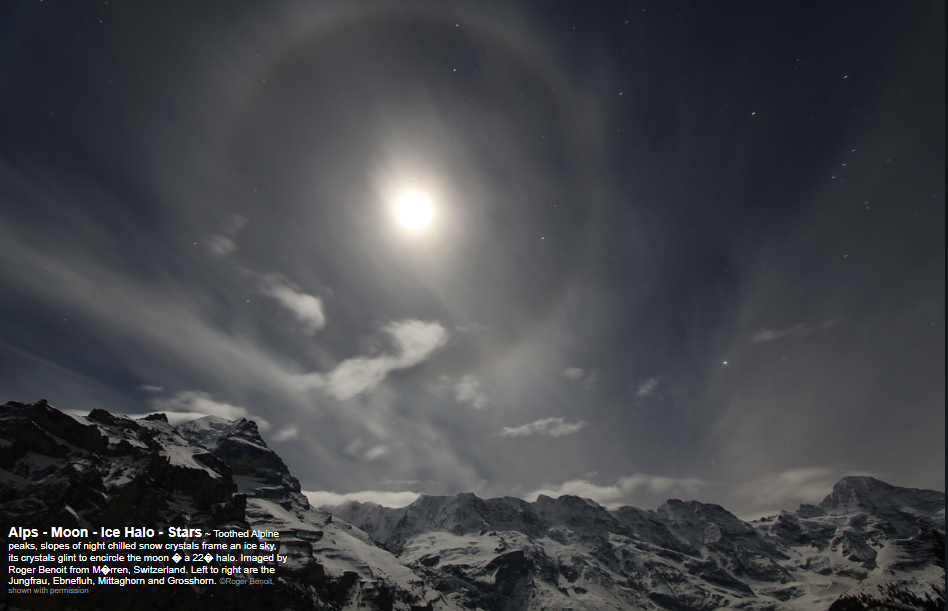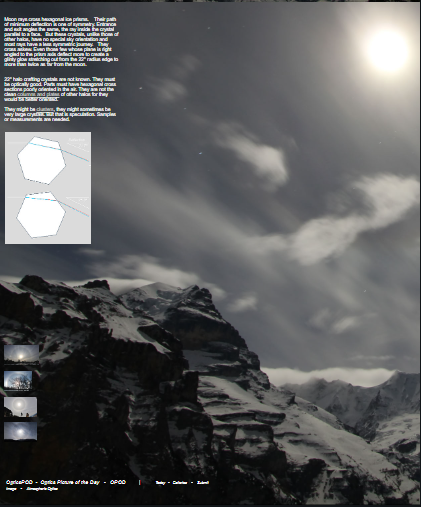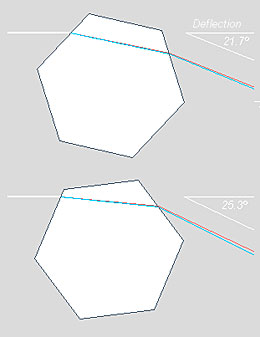OPOD - Alps, Moon, Halo
OPOD - Alps, Moon, Halo: A Spectacular Display of Ice Crystals in the Sky
When it comes to atmospheric optics, there are few phenomena as captivating as the sight of a halo encircling the moon. In a recent photograph taken by Roger Benoit from Mürren, Switzerland, we are treated to a breathtaking view of the moon framed by the toothed peaks of the Alps and surrounded by a shimmering ice halo. This stunning image not only showcases the beauty of nature but also provides us with an opportunity to delve deeper into the fascinating science behind this optical phenomenon.
The moon's rays, as they pass through hexagonal ice prisms in the atmosphere, undergo a process of deflection. This deflection follows a path of symmetry, where the entrance and exit angles of the rays are the same, and the ray inside the crystal remains parallel to a face. However, unlike other halos, the crystals responsible for the 22° halo observed in this photograph do not have a specific sky orientation. As a result, most rays experience a less symmetric journey, crossing askew through the crystals.
Even those few rays whose plane is right-angled to the prism axis still undergo significant deflection, creating a glinty glow that extends beyond the 22° radius edge to more than twice that distance from the moon. The crafting of these unique crystals remains somewhat of a mystery. They must possess optical properties that allow for the formation of the halo, and their hexagonal cross-sections are likely poorly oriented in the air, unlike the clean columns and plates observed in other halos.
One possibility is that these crystals exist in clusters or are occasionally very large in size, but without further samples or measurements, this remains speculative. Scientists continue to explore and study these intriguing ice crystals to gain a better understanding of their formation and properties.
The Science Behind Ice Halos
Ice halos are a type of optical phenomenon that occurs when light interacts with ice crystals in the atmosphere. These crystals act as prisms, bending and refracting the light, resulting in the formation of various halos, arcs, and other captivating displays. Understanding the science behind these phenomena requires a closer look at the properties and behavior of ice crystals.
Hexagonal Ice Prisms
The ice crystals responsible for halos, including the 22° halo observed in the Alps-Moon image, are hexagonal in shape. This hexagonal structure plays a crucial role in the formation of halos, as it determines how the light is refracted and scattered as it passes through the crystal.
Symmetry and Deflection
As light enters a hexagonal ice prism, it follows a path of symmetry. The entrance and exit angles of the rays are the same, and the rays inside the crystal remain parallel to a face. However, due to the lack of specific sky orientation in the crystals observed in this particular halo, most rays experience deflection at varying angles, resulting in a less symmetric journey through the crystal.
Glinty Glow and Extended Halo
The deflection of light rays within the ice crystals gives rise to a glinty glow that extends beyond the 22° radius edge of the halo. Even rays with a right-angled plane to the prism axis undergo significant deflection, contributing to this extended glow. The exact mechanisms behind this phenomenon are still being investigated, with scientists aiming to determine the factors that influence the intensity and extent of this glinty glow.
Unraveling the Mystery
Despite the captivating beauty of ice halos, there is still much to learn about their formation and characteristics. The crafting of the specific crystals responsible for the 22° halo observed in the Alps-Moon image remains unknown. To gain a deeper understanding, researchers require samples or measurements that can provide valuable insights into the properties and structure of these crystals.
Clustered Crystals
One hypothesis suggests that the crystals responsible for the 22° halo may exist in clusters. These clusters could potentially create unique optical properties that allow for the formation of the halo. By studying the distribution and arrangement of these clusters, scientists hope to uncover the underlying mechanisms behind their formation.
Large Crystals
Another possibility is that the crystals themselves are exceptionally large. Larger crystals would have a greater impact on the deflection of light rays, potentially resulting in the extended glow observed in the 22° halo. However, without direct measurements or observations, this hypothesis remains speculative.
Conclusion
The OPOD - Alps, Moon, Halo image provides us with a captivating glimpse into the world of atmospheric optics. The intricate interplay between light and ice crystals gives rise to stunning displays such as the 22° halo observed in this photograph. While many aspects of this phenomenon remain a mystery, scientists continue to investigate and study these unique ice crystals, hoping to unravel their secrets and gain a deeper understanding of the complex processes that shape our skies. As we marvel at the beauty of nature's creations, let us also appreciate the tireless efforts of researchers striving to unlock the mysteries of the universe above us.

Alps - Moon - Ice Halo - Stars ~ Toothed Alpine peaks, slopes of night chilled snow crystals frame an ice sky, its crystals glint to encircle the moon � a 22� halo. Imaged by Roger Benoit from M�rren, Switzerland. Left to right are the Jungfrau, Ebnefluh, Mittaghorn and Grosshorn. ©Roger Benoit, shown with permission
Moon rays cross hexagonal ice prisms. Their path of minimum deflection is one of symmetry. Entrance and exit angles the same, the ray inside the crystal parallel to a face. But these crystals, unlike those of other halos, have no special sky orientation and most rays have a less symmetric journey. They cross askew. Even those few whose plane is right angled to the prism axis deflect more to create a glinty glow stretching out from the 22° radius edge to more than twice as far from the moon.
22° halo crafting crystals are not known. They must be optically good. Parts must have hexagonal cross sections poorly oriented in the air. They are not the clean columns and plates of other halos for they would be better oriented.
They might be clusters, they might sometimes be very large crystals. But that is speculation. Samples or measurements are needed.


Note: this article has been automatically converted from the old site and may not appear as intended. You can find the original article here.
Reference Atmospheric Optics
If you use any of the definitions, information, or data presented on Atmospheric Optics, please copy the link or reference below to properly credit us as the reference source. Thank you!
-
<a href="https://atoptics.co.uk/blog/opod-alps-moon-halo/">OPOD - Alps, Moon, Halo</a>
-
"OPOD - Alps, Moon, Halo". Atmospheric Optics. Accessed on November 26, 2024. https://atoptics.co.uk/blog/opod-alps-moon-halo/.
-
"OPOD - Alps, Moon, Halo". Atmospheric Optics, https://atoptics.co.uk/blog/opod-alps-moon-halo/. Accessed 26 November, 2024
-
OPOD - Alps, Moon, Halo. Atmospheric Optics. Retrieved from https://atoptics.co.uk/blog/opod-alps-moon-halo/.